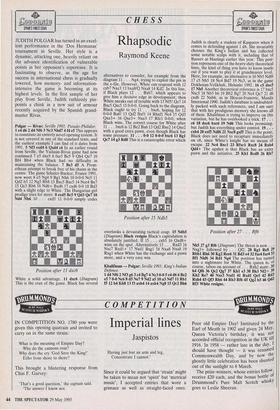Rhapsodic
Raymond Keene
JUDITH POLGAR has turned in an excel- lent performance in the 'Dos Hermanas' tournament in Seville. Her style is a dynamic, attacking one, heavily reliant on the advance identification of vulnerable points in her opponent's repertoire. It is fascinating to observe, as the age for success in international chess is gradually lowered, how memory- and information- intensive the game is becoming at its highest levels. In the first sample of her play from Seville, Judith ruthlessly pin- points a chink in a new suit of armour recently acquired by the Spanish grand- master Rivas.
Polgar — Rivas: Seville 1993; Pseudo-Philidor. 1 e4 d6 2 d4 Nf6 3 Nc3 Nbd7 4 f4 e5 This appears to constitute an entirely novel opening system. It is not covered in any of the standard texts, and the earliest example I can find of it dates from 1991. 5 Nf3 exd4 6 Qxd4 c6 In an earlier round from Seville, the Yudasin-Rivas game had now continued 7 e5 dxe5 8 fxe5 Bc5 9 Qh4 0e7 10 Bf4 Bb4 when Black had no difficulty in maintaining the balance. 7 Be3 d5 A Prom- ethean attempt to break free of his chains in the centre. The game Schafer-Bucker, France 1991, now went 8 e5 Ng4 9 Bgl Nh6 10 0-0.0 Nc5 11 Qd2 b5 12 Ng5 Rb8 13 Bxc5 Bxc5 14 Nce4 Be7 15 Qc3 Rb6 16 Nd6+ Bxd6 17 cxd6 0-0 18 Bd3 with a slight edge to White. The Hungarian girl prodigy tries for more. 8 exd5 Bc5 9 Qd3 Qe7 10 Nd4 Nb6 10 . . cxd5 11 0-0-0 simply cedes
Position after 11 dxc6
White a solid advantage. 11 dxc6 (Diagram) This is the crux of the game. Black has several alternatives to consider, for example from the diagram 11 . . . Ng4, trying to exploit the pin in the e-file. However, White can respond with 12 cxb7 Nxe3 13 bxa8/Q Nxa8 14 Kd2. In this line, if Black plays 12 . . . Bxb7, which appears to give him a decisive edge in development, then White sneaks out of trouble with 13 Nf5! Qc7 14 Bxc5 Qxc5 15 0-0-0. Going back to the diagram, Black ought to try 11 . . . bxc6, hoping for 12 0-0-0 Ba6! 13 Qd2 Bxfl 14 Rhxfl Nc4 15 Qd3 Qxe3+ 16 Qxe3+ Nxe3 17 Rfel 0-0-0, when Black wins. The correct course for White after 11 . . . bxc6 is 12 Bet Ba6 13 Qd2 Bxe2 14 Qxe2 with a good extra pawn, even though Black has some pressure. 11 . . . 0-0 12 0-0-0 bxc6 13 Bgl Qc7 14 g3 Rd8 This is a catastrophic error which Position after 15 NdbS overlooks a devastating tactical coup. 15 NdbS (Diagram) Black resigns Black's capitulation is absolutely justified. If 15 . . . cxb5 16 Qxd8+ wins on the spot. Alternatively 15 . . Rxd3 16 Nxc7 Rxdl+ 17 Nxdl Bxgl 18 Nxa8 Nxa8 19 Rxgl when White has the exchange and a pawn more, and a very easy win.
Khalifman — Polgar: Seville 1993; King's Indian Defence.
1 d4 Nf6 2 Nf3 g6 3 c4 Bg7 4 Nc3 0-0 5 e4 d6 6 Be2 e5 7 0-0 Nc6 8 d5 Ne7 9 Nd2 a5 10 a3 Nd7 11 Rbl f5 12 b4 Kh8 13 f3 axb4 14 axb4 Ng8 15 Qc2 Bh6
Judith is clearly a student of Kasparov when it comes to defending against 1 d4. She invariably chooses the King's Indian and has collected some notable scalps with it, including that of Bareev at Hastings earlier this year. This posi- tion represents one of the heavy-duty theoretical lines, the kind of thing you have to know inside out if you want to play it at grandmaster level. Here, for example, an alternative is 16 Nb5 Ndf6 17 c5 Nh5 18 Nc4 Bd7 19 Nc3, as in the game Dokhoian-Velikhali, Helsinki 1992. 16 c5 dxc5 17 Nb5 Another theoretical reference is 17 bxc5 NxcS 18 Nb5 b6 19 Bb2 Bg7 20 Nc4 Qe7 21 d6 cxd6 22 Nxb6, as in Illescas-Ivanovic, Manila Interzonal 1990. Judith's database is undoubted- ly packed with such references, and I am sure that with her prodigious memory she knows all of them. Khahfman is trying to improve on this variation, but he has overlooked a trick. 17 . . c6 18 dxc6 bxc6 19 Nd6 This looks promising, but Judith has everything under control. 19 . . cxb4 20 exf5 Ndf6 21 NxcS gxf5 This is the point; Black does not need to recapture immediately on c8, since White's knight has no means of escape. 22 Nc4 Bxcl 23 Rfxcl Rxc8 24 Rxb4 Qd4+ The upshot is that Black has an extra pawn and the initiative. 25 Khl RcdS 26 Rb7 Position after 27 . . . Rf6 Nh5 27 g3 Rf6 (Diagram) The threat is now . • Nxg3+ followed by . . . Qf2. 28 Rgl Re8 29 Rbbl Rh6 30 Kg2 Ree6 31 Bd3 e4 32 fxe4 fxe4 33 Bfl Nhf6 34 Rdl Ng4 The position has turned into a nightmare for White. The queen is, of course, taboo on account of . . . Rxh2 mate. 35 h4 Qf6 36 Qe2 Qg7 37 Khl e3 38 Bh3 Nf2+ 39 Kh2 Re7 40 Nxe3 Nxdl 41 Rxdl Qe5 42 Rd3 Rxh4 43 Q13 Rh6 44 Rb3 Rf6 45 Qg2 h5 46 Qd2 Rf3 White resigns.


















































 Previous page
Previous page